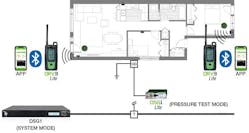In today’s competitive landscape for broadband services, it is of utmost importance to ensure the very best experience to subscribers. Technology is continually evolving, and as cable operators upgrade their HFC plants to deliver specialty programming and HDTV, the last stretch of cable that connects residential areas and businesses is not to be overlooked.
Cable TV technicians primarily operate within the home and are at the forefront of potential events or cable issues. As such, they are best positioned to bridge the gap between the external plant and the subscriber’s premises. Not only do they troubleshoot and solve problems, but they also engage in first-hand customer experience.
For this reason, training and equipping technicians to get the installation right is paramount in turning customers into lifelong clients. This starts with adding a critical step as part of their installation routine: tracking potential cable shielding integrity issues. By having installation technicians make sure no existing impairment will eventually degrade their cable network on the one hand, and using the best quality passive equipment for installations on the other hand, MSOs can be confident that their subscribers will get what they yearn for: clarity, speed and, above all, long-term satisfaction.
Why is tracking potential shielding integrity issues so critical?
One might argue that cable operators already have enough control over their shielding performance. I would say that is only partially true, since their performance is mostly limited to the outside plant. When it comes to customer homes, you get a completely different picture. Just think of when people buy a couple of new television sets, or when they build an extra room with a do-it-yourself type of wiring. In such cases, there can be a shielding effectiveness difference of up to 50 dB between the cable operator’s professionally installed passive equipment, such as coaxial drop and splitters, and the same type of passive equipment of a lower build quality purchased and installed by the client.
On top of that, with the additional LTE spectrum now falling directly into the broadband cable spectrum, impairment events are on the rise. Cable leakage in the UHF spectrum can also cause harmful interference to over-the-air services such as broadcast television, LTE, public safety, trunked two-way radio and other communications. Considering not only the compliance requirements adopted by the Federal Communications Commission (FCC) to address these issues under Part 76, but also the repeated truck rolls incurred due to such interferences, controlled quality installations should be regarded as increasingly important for cable operators.
MSO’s best bet: adopting a preventive quality assurance approach
The best way to increase shielding effectiveness across the plant is using a preventive approach. This involves the addition of a quality installation control process while your installation staff is already at the customer premises. Such an approach has tremendous benefits. It reduces customer service calls, truck rolls and mean time to repair. It ensures compliance with the FCC Part 76 regulations. It increases the cable network’s achievable spectral efficiency. And above all, it ensures a higher level of customer satisfaction, not to mention the role it plays in achieving sustainability (but let’s save that discussion for another day).
Let’s get practical
| Actionable Advice for Installation Technicians |
|---|
|
To get going with a preventive quality assurance approach, the first step would be for cable operators to make sure the best quality passive equipment is used, to increase their plant’s shielding integrity. One thing to check for is whether the cable installation procedure is being correctly applied by staff and contractors.
Staff should discard any passive equipment not provided by the company, since this equipment will likely have insufficient shielding integrity against interferences.
Once a cable installation or service call has been completed, a proactive step should be included to the service procedure: performing a “leakage pressure test.” This will ensure there is no cable leakage present.
A leakage pressure test is conducted by applying a high RF level set of carriers at the drop input. While using a cable leakage receiver, the staff will walk through each room within the customer’s premises to make sure that there are no leaks present before they leave, thus avoiding potential expensive and polluting truck rolls.
Working with the right tools
The first aspect to look out for when selecting detection tools is that they come in a comprehensive, ready-to-use kit. The kit should include all devices necessary to ensure total quality for in-home and multiple dwelling unit (MDU) installations, chiefly enabling easy and efficient leakage and ingress detection and repairs.
Devices should be user-friendly and operate in a continuous mode. This will ensure that once technicians have completed their installation work, they can easily make sure no impairments are present that could show up within the cable network. Moreover, as the technicians will be carrying their gear all day, the devices should be lightweight and have a good battery life.
Egress and ingress pressure tests
Technicians will be more effective in identifying hard-to-find events if the devices they use enable them to pressure test both egress and ingress using high-level test signals. Operators will also get a better overview of all in-home issues if devices come with documented, time-stamped detection and repair processes. Features like timestamps will also help them validate their technicians’ or subcontractors’ productivity.
Dual-mode leakage testing
Kits should enable the performance of both pressure and systems tests. When working in pressure test mode, technicians should typically carry a portable device that generates leakage carriers, which in turn would be detected by a portable digital leakage meter. The meter should work in dual mode, and be dual-frequency agile. An example of such a kit in action is shown in Figure 1. With its dual-tuner design, the detection meter provides simultaneous visual and audio indication of detected leaks in the VHF and UHF bands. Alternatively, if technicians are working in system mode, the leakage carriers are generated by a signal generator located at the head-end. Switching from system to pressure test mode can be done with a press of a button.
Figure 1. Pressure test and system mode kits for in-home installation certification using a continuous egress and ingress monitoring system.
Ticket management via mobile application
Equipping technicians with a mobile application for managing their repair tickets is great for boosting efficiency. For example, techs can be assigned new installation or repair tickets in real time. They can also create events in offline mode, thus saving on mobile coverage charges. They could use the app to record measurements before and after their intervention. The app would also enable them to close-out events.
Web-based management
Plant managers want to make efficiency gains with their preventive maintenance program. A web-based management application that can be accessed from anywhere, anytime by an unlimited number of authorized users may help them shorten the lifecycle of leakage and ingress events and consequently reduce the number of service calls. The application should be able to store data in an open format. This will facilitate custom reporting and integration with cable operators’ other systems.
A worthwhile investment
It goes without saying that adopting a preventive approach involving testing shielding integrity entails efforts in terms of resources and installation staff training. Considering the impact of new technologies on cable leakage and ingress – among them DOCSIS 3.1 – and given the huge benefits to be expected in the long run from such an approach, the investment is no doubt worthwhile, whether you see it in terms of service call and related carbon footprint reduction, regulatory compliance or customer satisfaction.
Ralph Ciarla oversees Customer Experience – CPAT FLEX, at Effigis Geo-Solutions.






